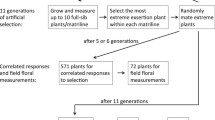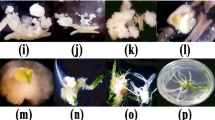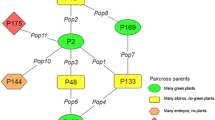Summary
Response frequencies in maize (Zea mays L.) anthers cultured in vitro were examined in a diallel set of crosses among four commercial inbred lines. Significant differences among the genotypes were observed, with the crosses H99xFR16 and Pa91xFR16 displaying the highest responses. General (GCA) and specific (SCA) combining ability mean squares were calculated and determined to be highly significant. GCA effects among the parental lines were highest for FR16 and lowest for LH38. Nongenotypic, plant-toplant differences were also found to make a significant contribution to the overall variation observed. The results from this study indicate that parents which give rise to highly responsive hybrids can be identified and that genetic improvement is possible through selection.
Similar content being viewed by others
References
Bajaj YPS (1983) In vitro production of haploids. In: Evans DA, Sharp WR, Ammirato PV, Yamada Y (eds) Handbook of plant cell culture, vol 1. Macmillan, New York, pp 228–287
Brettell RIS, Thomas E, Wernicke W (1981) Production of haploid maize plants by anther culture. Maydica 26: 101–111
Dieu P, Beckert M (1986) Further studies of androgenetic embryo production and plant regeneration from in vitro cultured anthers of maize (Zea mays L.). Maydica 31: 245–260
Genovesi AD, Collins GB (1982) In vitro production of haploid plants of corn via anther culture. Crop Sci 22: 1137–1144
Griffing B (1956) Concept of general and specific combining ability in relation to diallel crossing systems. Aust J Biol Sci 9:463–493
Ku MK, Cheng WC, Kuo LC, Kuan YL, An HP, Huang CH (1978) Induction factors and morpho-cytological characteristics of pollen-derived plants in maize (Zea mays L.). Proc Symp Plant Tissue Cult 1978. Science Press, Peking, pp 35–42
Nitsch C, Anderson S. Godard M, Neuffer MG, Sheridan WF (1982) Production of haploid plants of Zea mays and Pennisetum through androgenesis. In: Earle ED, Demarley Y (eds) Variability in plants regenerated from tissue culture. Praeger Publishers, New York, pp 69–91
Pace GM, Reed JN, Ho LC, Fahey JW (1987) Anther culture of maize and the visualization of embryogenic microspores by fluorescent microscopy. Theor Appl Genet 73:863–869
Petolino JR, Jones AM (1986) Anther culture of elite genotypes of maize. Crop Sci 26:1072–1074
Ting YC, Yu M, Zheng WZ (1981) Improved anther culture of maize (Zea mays L.). Plant Sci Lett 23:139–145
Wu J (1986) Breeding haploid corn by anther culture. In: Hu H, Yang H (eds) Haploids of higher plants in vitro. Springer, New York, pp 149–161
Author information
Authors and Affiliations
Additional information
Communicated by G. Wenzel
Rights and permissions
About this article
Cite this article
Petolino, J.F., Thompson, S.A. Genetic analysis of anther culture response in maize. Theoret. Appl. Genetics 74, 284–286 (1987). https://doi.org/10.1007/BF00289982
Received:
Accepted:
Issue Date:
DOI: https://doi.org/10.1007/BF00289982




